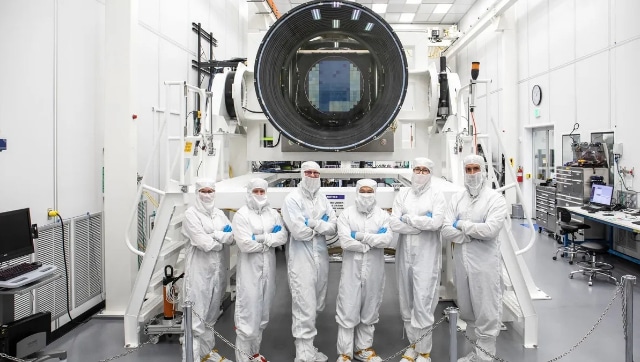Mehul Reuben DasOct 19, 2022 14:05:29 IST
Engineers at the SLAC National Accelerator Laboratory in the USA have finally assembled all parts of the world’s largest digital camera. The project, which started out a couple of years ago, was aimed at putting the camera up on an observatory in the Chilean Andes.

A team of engineers at the SLAC National Accelerator Laboratory, with the LSST camera. The camera has a resolution of 3200MP or 3.2 Gigapixels. Image Credit: SLAC National Accelerator Laboratory
Although the camera isn’t functional yet, the engineers and scientists were able to fit all of the components into an operable frame, so that visitors could see its focus plane and composite sensor, which uses 189 different CCD sensors. So great is the resolution of the new camera, that its engineers claim they can shoot a photograph of a single speck of dust on the moon’s surface.
What is the LSST Camera?
To put it in simplistic terms, the LSST or the ‘Large Synoptic Survey Telescope’ is a digital camera that is being engineered and developed to be placed onto the El Penon peak of Cerro Pachon, a 2,682-meter-high mountain in the Coquimbo Region, in northern Chile. Cerro Pachon is considered one of the best places on earth for an observatory. That is the reason, why the mountain peak also hosts the Gemini South and Southern Astrophysical Research Telescopes.
How was the LSST camera made?
A team of engineers helped in designing and manufacturing 189 CCD sensors. CCD sensors or charge-coupled device is an integrated circuit which contains an array of linked or coupled, capacitors. CCD sensors are a major technology used in digital imaging, especially when we’re dealing with ultra-high resolution cameras, that need to be coupled with super-telephoto lenses.
These sensors were then laid across an array very carefully, for any misalignments would have caused a number of sensors to be destroyed. Moreover, each of the individual sensors would cost a lot to be remanufactured.
The team of engineers at the SLAC National Accelerator Laboratory is currently testing out the shutter system and the system to change filters. And no, the LSST does not use digital filters like the one that we see on Snapchat and Instagram – it uses physical filters that block out certain wavelengths.
What is the resolution of the LSST camera?
The LSST camera uses 189 sensors. Each of these sensors measures 16mm diagonally, and has a pixel density that is higher than that of the latest iPhone 14 Pros. Each individual sensor is also bigger than the sensor size of an iPhone. The overall resolution of the composite sensor is 3.2 Gigapixels or 3200 Megapixels. That’s a resolution that’s more than 260 iPhone 14 Pros combined.
The sensor has been paired with a super-telephoto lens that has a diameter of 1.57 meters, making it the biggest lens of its kind to be ever created. The end result is, from where it will be placed on earth, the LSST camera can take a photo of a dust particle, on the surface of the moon.
Engineers at the SLAC National Accelerator Laboratory are currently testing the shutter system of the camera. They need to install a cooling system before the LSST is deployed. Image Credit: SLAC National Accelerator Laboratory
When will the LSST camera be deployed?
The team at the SLAC National Accelerator Laboratory still needs to install the cooling system that has been designed for the SLAC National Accelerator Laboratory. Because the LSST camera deals with a lot of data, and uses a lot of electricity, it generates a lot of heat as well, which needs to be dissipated quickly.
The cooling system will be installed by the end of the year. The camera will then undergo a series of tests, before it is finally shipped of to Chile in May 2023. Once it reaches the observatory it is destined for, it is expected to be operational.
{n.callMethod? n.callMethod.apply(n,arguments):n.queue.push(arguments)}
; if(!f._fbq)f._fbq=n;n.push=n;n.loaded=!0;n.version='2.0'; n.queue=[];t=b.createElement(e);t.async=!0; t.src=v;s=b.getElementsByTagName(e)[0]; s.parentNode.insertBefore(t,s)}(window,document,'script', 'https://connect.facebook.net/en_US/fbevents.js'); fbq('init', '259288058299626'); fbq('track', 'PageView');
For all the latest Technology News Click Here
For the latest news and updates, follow us on Google News.
